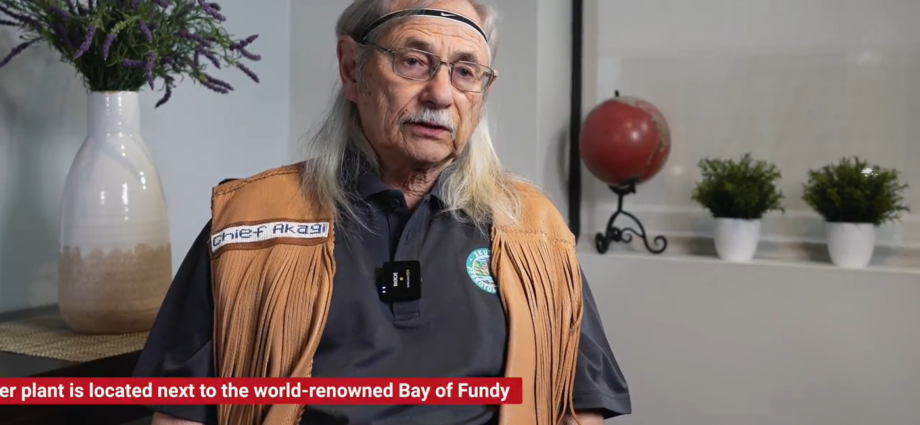
By John Chilibeck, Local Journalism Initiative Reporter, The Daily Gleaner
May 1, 2024
Four Indigenous leaders from New Brunswick, Quebec and Ontario have made a special appearance in Ottawa to condemn the storage of dangerous and long-lasting nuclear waste on their traditional territories.
The leaders argued at a press conference Tuesday that the federal government hadn’t obtained their consent for the expansion of nuclear energy and the production of more radioactive waste, violating the United Nations Declaration on the Rights of Indigenous Peoples, which Canada signed it in 2016.
The declaration contains a key passage that reads: “States shall take effective measures to ensure that no storage or disposal of hazardous materials shall take place in the lands or territories of Indigenous peoples without their free, prior and informed consent.”
One of the nuclear opponents was Chief Hugh Akagi of the Peskotomuhkati Nation who lives in St. Andrews.
“I represent a people who welcomed your people to stay here in 1604,” he said to reporters at a press conference, referring to the French explorer Samuel de Champlain’s contact with Indigenous people in the St. Croix area. “Four hundred years later, I’m back again, because you needed our help then, and I think you need our help now.”
The Pasamaquoddy people he leads consider part of their homeland Point Lepreau, site of New Brunswick’s only nuclear generator, in operation for four decades.
NB Power’s reactor was built and later refurbished without his nation’s consent.
The plant is in the news again because Ottawa and New Brunswick are spending public funds to develop two new small nuclear reactors on the same property just west of Saint John on the Bay of Fundy in the southern portion of the province.
Ron Tremblay, who calls himself the hereditary grand council chief of the Wolastoqiyik in New Brunswick, said his own people, who live along the St. John River and its tributaries, are also affected by the plant.
“My concern as a traditional chief is if we export the nuclear waste and deliver it through over 425 Indigenous communities, the possibility of spills and accidents will occur,” he said, adding he had a problem with placing such waste into the ground of someone else’s Indigenous homeland.
A leader at Mississagua First Nation in southern Ontario is fed up with the Blind River uranium refinery run by the publicly-traded firm Cameco.
“The existence of nuclear operations on our ancestral lands has contributed to our loss of culture and spiritual traditions and has been detrimental to our health,” said Mississauga First Nation Councillor Peyton Pitawanakwat. “Cameco has materially benefitted and continues to benefit, from the operations at Blind River, which remains the world’s largest uranium refinery. The proposal to now site radioactive wastes on our lands would perpetuate an existing environmental injustice and amount to environmental racism.”
Meanwhile, the chiefs of two First Nations near the Ottawa River, or Kichi Sibi, which forms part of the boundary between Ontario and Quebec, are furious about plans to build a big radioactive waste facility at Chalk River Laboratories.
“The Kichi Sibi is sacred to our peoples and at the heart of our unceded homeland,” said Chief Lance Haymond, of Kebaowek First Nation. “The Algonquin peoples never consented to the Chalk River site being used for over 75 years for nuclear reactors and research, and now being the site for a permanent radioactive waste dump. Consultation was far too late and inadequate, and we reject the plan.”
Despite opposition to the project by 10 Algonquin First Nations, the Canadian Nuclear Safety Commission approved the disposal mound in January 2024. Two First Nations have launched a legal challenge to the decision, as have several citizen groups.
Not all Indigenous leaders in New Brunswick are opposed to nuclear energy. The Green Party of Canada helped organize Tuesday’s press conference, but conspicuously absent were the chiefs from seven Mi’kmaq communities in New Brunswick who have invested in two companies that want to build small nuclear reactors in the province.
They say nuclear energy is a good alternative to burning fossil fuels, whose greenhouse gases threaten to keep warming the earth, making it unlivable.
The North Shore Mi’kmaq Tribal Council and the seven First Nations whose communities hug New Brunswick’s northern and eastern shores last year made financial investments in both the Moltex and ARC nuclear firms, via separate agreements.
One will see them receiving $2 million in share value from Moltex, and the other $1 million in share value from ARC.
During the announcement last September, Indigenous leaders said they’d struck the historic, unprecedented deal to help avert a global warming crisis and to create jobs for young First Nations people, along with renewed economic activity in their communities.
“As a wise elder once told me, for many years, we’ve watched industry pass us by,” said Terry Richardson, the chief of Oinpegitjoig (Pabineau First Nation), at the Saint John Arts Centre.
“We’ve watched the trucks pass by our communities hauling minerals, hauling stuff, but no benefit for First Nations. Now, we’re at the table. We’re having benefit. And it will create wealth.”
Subscribe to our newsletter.

